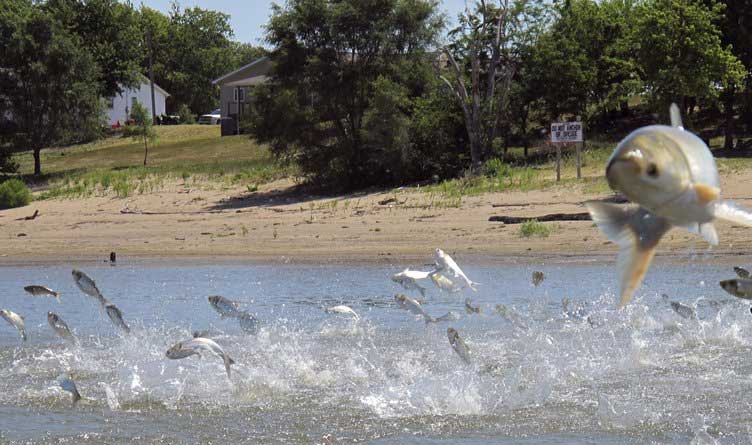Photo: In this June 13, 2012, file photo, Asian carp, jolted by an electric current from a research boat, jump from the Illinois River near Havana, Illinois.
Photo Credit: John Flesher / AP
Published February 22, 2021
Upper Tennessee and Cumberland river basins have been having issues with the invasive Asian carp species spreading.
Watts Bar Ecology and Fishery Council issued a report stating that closing the lock at the Watts Bar Dam could help alleviate the problem.
The 26-page report came from biologists at the fishery, as well as chairperson Timothy Joseph. The report lays out ways to prevent and control the invasive species, including plans for funding.
In a letter that Joseph wrote to Tennessee Governor Bill Lee, he said the plan “would prevent a more than $1 billion annual economic loss to the Upper Tennessee River Basin and prevent ecological devastation.”
The letter went on to say, “It is my hope that after reading this report, you as governor along with the [Asian Carp Advisory] Commission, see the opportunity to earn a legacy beyond measure — saving the Upper Tennessee River Basin of four magnificent lakes — Watts Bar, Melton Hill, Fort Loudon, and Tellico Lakes — from ecological and economic devastation.”
According to Joseph, all efforts to curb the invasive species so far have been unsuccessful. If the problem remains, it could destroy the ecosystem of many of the lakes in the area.
“These lakes will follow the same path of devastation that has occurred at The Land Between the Lakes if the silver carp are not stopped. There is no doubt about that whatsoever. It will take place,” Joseph said.
In addition to a blockade at Watts Bar, the Tennessee fisheries chief said getting help from interstate partners would be essential to doing work further downstream.
There are four species of Asian carp, black, grass, silver, and bighead, that are considered to be invasive. However, the silver and bighead are said to be the ones doing the most damage. Silver carp can reach sixty pounds and often leap from the water, which could injure boaters or skiers. All four were originally brought into the United States during the 60s and 70s.
The report states that the Watts Bar lock would consist of two barriers. The bioacoustic barrier could be up within ten months while the electric one could take between four and five years. It’s more expensive but also more effective in keeping the carp from going upstream.
“Closure of the Watts Bar Lock will have a temporary negative impact on the river transportation industry and recreational boaters. At the same time, it will have a positive impact on rail and truck transportation,” Joseph said. However, he said the financial impact from a worsened carp invasion would be worse.
According to Joseph, any of these negative consequences should “last only while the lock is closed.”
While this could lead to a few million dollars lost a year, Joseph said a carp invasive could easily cost over $1 billion in losses annually. He said the lock is “clearly an acceptable temporary impact.”
The plan lists various forms of taxes for lake users, boaters, and anglers, as well as fees for fishing tournaments as ways to fund the two barriers.





